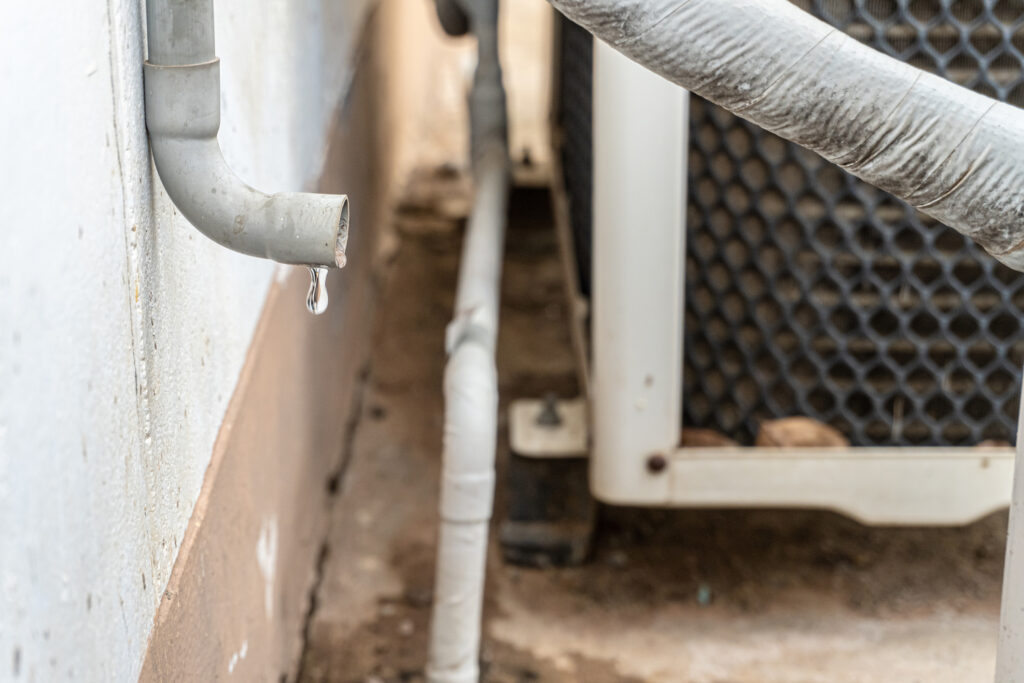If your air conditioner suddenly starts leaking water or stops cooling efficiently, a clogged drain line might be the culprit. This small but vital component plays a big role in keeping your system working properly and your home free of water damage. Fortunately, with a little know-how, unclogging an AC drain line is something many homeowners can handle on their own.
In this blog, we’ll walk you through how to unclog an AC drain line, what causes the clog in the first place, and how to prevent it from happening again. We’ll also explain when it’s time to call in the pros.
What Is an AC Drain Line?
Your air conditioner not only cools your home, but it also removes moisture from the air. This moisture collects on the evaporator coil and drips into a drain pan. From there, it flows out of your home through a narrow plastic or PVC pipe called the condensate drain line.
Over time, that drain line can collect dust, dirt, algae, mold, or even insect nests. If it becomes clogged, the water has nowhere to go and may back up into your home or cause the system to shut down.
Signs Your AC Drain Line Is Clogged
Before learning how to unclog an AC drain line, you should be able to recognize when it’s clogged. Some common signs include:
- Water pooling near your indoor unit or dripping from the ceiling (if your air handler is in the attic).
- Musty or mildewy odors, indicating moisture buildup.
- System shutting down due to the overflow safety switch being triggered.
- Unusual humidity levels inside the home, even when the AC is running.
- Visible mold or algae around the drain line exit outside.
If you notice any of these issues, it’s a good idea to check the drain line first.
How to Unclog an AC Drain Line: Step-by-Step
Here’s a safe, step-by-step guide for unclogging your air conditioner’s drain line using basic household tools and supplies.
Step 1: Turn Off the Power
Before doing anything, shut off your AC system at the thermostat and circuit breaker. This prevents the risk of electrical shock and keeps the system from turning on while you’re working.
Step 2: Locate the Drain Line
Find the condensate drain line, which is typically a white or clear PVC pipe located near the indoor air handler. Look for the access point or T-shaped vent with a removable cap—this is where you’ll do most of your cleaning.
Step 3: Check for Visible Clogs
Remove the cap and use a flashlight to inspect the drain line. If you see debris, mold, or algae buildup near the opening, use a stiff wire brush or a piece of flexible wire to gently dislodge it.
Step 4: Use a Wet/Dry Vacuum
Head outside to the end of the drain line (usually near the condenser unit) and connect a wet/dry shop vacuum to the pipe. Use a rag or duct tape to create a tight seal, then run the vacuum for about 2–3 minutes to suck out the clog. You may notice a dark, slimy substance in the vacuum afterward—that’s the blockage.
Step 5: Flush with Vinegar
Once the clog is removed, pour one cup of distilled white vinegar into the access point. Let it sit for 30 minutes to break down any remaining residue inside the pipe. Then rinse it with warm water to flush the line completely. You can do this step monthly as a preventative measure.
Optional Method: Use a Condensate Line Cleaner
There are commercial condensate drain line cleaning solutions available that are safe for your system and can be used in place of vinegar. Always follow the manufacturer’s instructions, and avoid using bleach, which can damage the pipes and harm your HVAC system over time.
How to Prevent Future Drain Line Clogs
Preventive maintenance is the key to avoiding future clogs and AC breakdowns. Here are a few simple tips:
- Flush the drain line monthly with vinegar or a safe cleaner.
- Replace your air filters regularly to prevent dust from entering the system.
- Schedule annual AC tune-ups with a professional HVAC technician.
- Install HVAC Algae Pads that release a powerful biocide in the evaporator coil.
- Inspect the outdoor drain line regularly to ensure it’s not blocked by leaves, dirt, or pests.
- Install a float switch to automatically shut off your system if the drain pan overflows—this can prevent major water damage.
These small actions can save you hundreds in repair costs and extend the life of your AC unit.
When to Call an HVAC Professional
While many minor clogs can be handled with DIY methods, it’s important to know when to step back and call a pro. You should contact a licensed HVAC technician if:
- The clog keeps coming back despite cleaning efforts
- Water damage has already occurred
- There’s mold or mildew in your ductwork or around your unit
- You hear unusual noises coming from your system
- The system still won’t turn on after you’ve cleaned the line
Professionals like the team at MSCO Inc. Heating & Cooling can use specialized tools such as pressurized CO₂, air compressors, or drain snakes to safely clear even the toughest blockages. We can also inspect the rest of your AC system to ensure no other issues are contributing to the problem.
Trust MSCO Inc. For Professional AC Service
Knowing how to unclog your AC drain line is a valuable skill for homeowners, but you don’t have to do it all alone. If you’re dealing with a persistent clog, water leak, or system failure, the certified technicians at MSCO Inc. Heating & Cooling are here to help.
We’ve proudly served Norfolk and the surrounding area since 1955. Our team is trained, licensed, and experienced with all makes and models of cooling systems. We offer fast, reliable service—day or night—and stand behind our work with trusted warranties and customer-first care.
Don’t wait until a small clog causes big damage. Call MSCO Inc. today at (757) 427-0016 or schedule your AC service online. We’ll keep your system running smoothly and your home cool all summer long.




